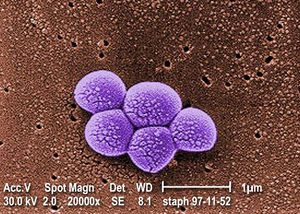Vibrio cholerae O1 Biotype El Tor: Virulence Factors
Introduction
Vibrio cholerae (V. cholerae) is a gram-negative pathogenic bacterium that causes diarrhea and dehydration in humans. There are more than 200 serogroups of V. cholerae, but only two – O1 and O139 – are associated with severe cholera epidemics (Ramamurthy et.al, 2020). The bacterium circulates between the aquatic environment and the human gut and is usually found in waters that have been contaminated by feces from an infected person (Ramamurthy et.al, 2020).
Vibrio cholerae serogroup O1 biotype El Tor (Serogroup O1) was the dominant strain of the 7th global cholera pandemic.

By Megan Lydon
At right is a sample image insertion. It works for any image uploaded anywhere to MicrobeWiki.
The insertion code consists of:
Double brackets: [[
Filename: PHIL_1181_lores.jpg
Thumbnail status: |thumb|
Pixel size: |300px|
Placement on page: |right|
Legend/credit: Magnified 20,000X, this colorized scanning electron micrograph (SEM) depicts a grouping of methicillin resistant Staphylococcus aureus (MRSA) bacteria. Photo credit: CDC. Every image requires a link to the source.
Closed double brackets: ]]
Other examples:
Bold
Italic
Subscript: H2O
Superscript: Fe3+
Sample citations: [1]
[2]
A citation code consists of a hyperlinked reference within "ref" begin and end codes.
To repeat the citation for other statements, the reference needs to have a names: "<ref name=aa>"
The repeated citation works like this, with a forward slash.[1]
Section 1
Include some current research, with at least one figure showing data.
Propionibacterium acnes is a gram-positive, fairly slow-growing aerotolerant bacterium. This bacteria is typically linked to the skin condition acne vulgris, commonly known as skin acne. This species is daily commensal and highly present on healthy skin epithelium. Little is detected on the skin of adolescents, specifically those pre-pubescent. This bacterium lives on fatty acids in sebum secreted by hair sebaceous glands in hair follicles. It can also be found in the gastrointestinal biome.
Section 2
Include some current research, with at least one figure showing data.
Section 3
Include some current research, with at least one figure showing data.
Section 4
Conclusion
References
Authored for BIOL 238 Microbiology, taught by Joan Slonczewski,at Kenyon College,2024
